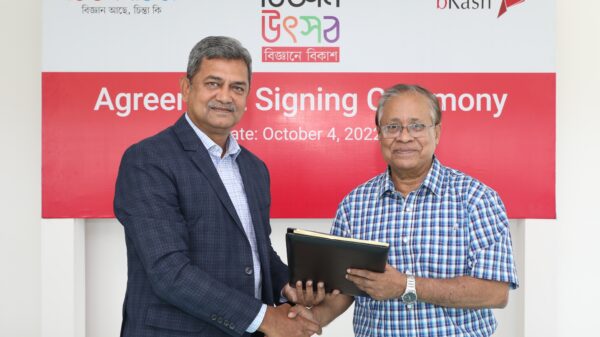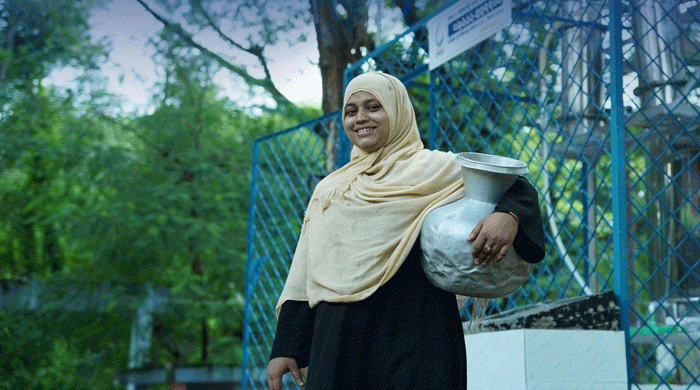Huawei and BGMEA join hands to walk toward a green Bangladesh

- MoU signed for installation of solar power plants at BGMEA enlisted garment factories
Staff Reporter Dhaka : The leading global ICT infrastructure provider Huawei has recently signed a Memorandum of Understanding (MoU) with BGMEA, the largest trade associations in the country representing the readymade garment industry, with a view to taking steps to address the current energy crisis and move towards a greener Bangladesh.
Bangladesh as well as the whole world is now going through a turbulent period due to fossilized fuel and gas crisis. In such a backdrop, it has become more important than ever to move towards alternative energy sources and strive for a greener Bangladesh by shifting the focus on green energy options like solar panels.
Realizing this, BGMEA has joined hands with Huawei for exploring green energy solutions. An MoU was signed between these two entities at BGMEA Complex, Uttara on 30 October 2022. Faruque Hassan, President, BGMEA and Mr. Pan Junfeng, CEO, Huawei Technologies (Bangladesh) Limited signed the MoU on behalf of their respective entities. Other high officials from Huawei and BGMEA were also present at the event.
Under this agreement, Huawei and BGMEA will work together to help the garment factories become ‘green factories’ by shifting to green source of energy. Huawei will be setting up solar power plants in the BGMEA enlisted factories following two modules – Opex and Capex. In the Opex module, factory owners will be able to enjoy less tariff rate than grid electricity. On the other hand, under the Capex module (1), Factory owner will make a long-term payment agreement with the Investor. After payment completed, Solar panel system belong to factory owner. There will also be another arrangement (Capex module 2), where factory owners will invest by themselves to set up rooftop solar system and can save electricity consumption by using solar energy. In both cases, BGMEA will regulate the processes and bridge the communication between Huawei and factories.
Meanwhile, the scope of this memorandum will also allow Huawei and BGMEA to build more than 2GW of solar rooftop system in garments industries, which will altogether generate probably 2600 GWh of clean electricity per year, minimizing the pressure on grid electricity and helping the country to deal with ongoing energy crisis. The system will also help factories to avoid 1.40 million tons of CO2 per year, which amounts to planting around 2.14 million trees. Such an initiative will help the industry to reduce its dependency on fossil fuel to a great extent and at the same time, the factories can save money by enjoying electricity tariff at a cheaper rate.
Faruque Hassan, president of Bangladesh Garment Manufacturers and Exporters Association (BGMEA), said at the event, “Energy efficiency, renewable energy and carbon footprint reduction have been one of the core areas of concern for BGMEA to facilitate sustainable growth and maintain competitiveness of the industry in the long run. Therefore, investments in renewable energy and energy efficient technologies has become imperative throughout the industry. SMEs represent a significant part of the industry, but due to the lack of finance, they are often hesitant to invest in sustainability or renewable energy. However, given the current trajectory of sustainability throughout the globe, an RMG exporter has no other way but to reduce their carbon footprint of the production. In such cases, OPEX model could be an ideal trade for them where, unlike the CAPEX model, the factories can reduce the carbon footprint of their products through green and renewable energy generation by using their empty rooftops.”
Pan Junfeng, CEO of Huawei Technologies (Bangladesh) Limited, said, “Currently the RMG sector of Bangladesh is going through a scarcity of proper power supply, resulting in the companies incurring cost hikes. As a solution, Huawei will work with BGMEA to fulfil the necessity of more power supply through green solutions (solar power). Eventually, this will help reduce excess power supply pressure on the national grid and the factories can move toward becoming green factories.”
It is mentionable that Huawei has already made investment in Bangladesh to set up solar plants in different regions of the country. At present, Huawei has dozens of rooftop projects and Solar IPP projects in Bangladesh. Out of all these, one of the largest Solar IPP project holds a capacity of 50 MW in Mymensingh, while the largest Solar IPP project in the poultry sector is 10 MW in Panchagarh.























 Chief Editor :
Md. Shohel Rana
Chief Editor :
Md. Shohel Rana